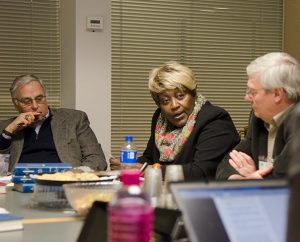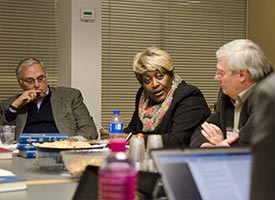By James H. Heine
ST. LOUIS — At a meeting here Feb. 20, an LCMS urban-mission roundtable considered whether the Church (and specifically the LCMS) has a role — or can play a role — in assisting low-income neighborhoods in bridging two gaps that often hinder efforts to improve the quality of life and economic opportunities.

The Rev. Steven D. Schave, director of LCMS Urban & Inner City Mission and LCMS Church Planting, hosted the meeting. Participants included Ronald K. Carter, founder and managing director of the Seven-Eight Company in St. Louis; the Rev. Jay DeBeir, vice-president of Horizon Health, Lewisville, Texas, and assistant pastor of St. John Church, Ellisville, Mo.; the Rev. David J. Vaughn, vice-president of Linkage, Burlington, Mass., and associate pastor of Christ Memorial Lutheran Church, St. Louis; Pat Woods-Quinn, president of Fresno’s Diner, St. Louis; Bill Lapp of LCMS Mission Advancement; Gary Olson, retired president and CEO of St. Luke’s Hospital, St. Louis; and George Vincent, managing partner and chairman of the Dinsmore law firm, Cincinnati.
While many government agencies, corporations, regional and local not-for-profits, and church-affiliated groups seek to improve the lives and enhance social and economic opportunities for the marginalized in society, two gaps frequently remain — wealth generation and job creation for communities overlooked by developers and investors, and making struggling communities attractive to middle- and high-income families (and thus enhancing the diversity of such communities), Schave wrote in a concept statement prepared for the meeting.
Lutheran service agencies have made great strides in offering aid to underserved communities, Schave noted. Lutheran Housing Support and the Synod’s “Planting Gospel Seeds While Serving Human Needs” program have offered turnkey solutions through affordable housing and human care as a means of loving our neighbor. While much can be accomplished in the realm of neighborhood revitalization and renewal, the gaps noted appear to remain outside regular avenues of community engagement, Schave offered.
Might an LCMS support organization, drawing on the expertise and resources of its members, have a role in bridging those gaps? he asked.
What’s missing in many poor communities are jobs — not only jobs created by large corporations, but also small-business jobs that often prove the engine of economic development in neighborhoods, Schave added in reference to the first item.
“Can our churches, with the right support, be locations for fostering small-business enterprise and entrepreneurship training in underserved neighborhoods?” he asked the group.
In discussing the gaps highlighted by Schave, participants stressed a number of issues, including an unintended but real tendency for agencies and institutions offering help to struggling communities to make the process of receiving that help so “institutional” that the voice of the recipients of the help, and their insight into the problems they face, is lost in the process.
Any such effort needs to begin with the basics, observed Woods-Quinn, a veteran of the corporate world whose new diner is the first restaurant to open in the College Hill neighborhood of St. Louis in decades. “Start by giving people the tools to help themselves,” she said. Then, when they have those tools mastered, “Let us find our own jobs.”
An advocate for her neighborhood, as well as an advocate of entrepreneurship and small business as a means to lift people out of poverty, Woods-Quinn noted the struggle many potential small-business owners — and by extension, potential future employers of others — face in poor communities: “No bank is going to lend you money when you live in College Hill,” she said.
Is this an example of “an empty spot we can fill?” Schave asked participants. Might a church-related entity, for example, serve as a conduit between loan applicants and venture-capital or “angel” investors?
Woods-Quinn, Vaughn and others also cautioned that making a community attractive to middle- and high-income families — often referred to as gentrification — should not come at the expense of a
community’s longtime residents being priced out of their neighborhood. Along with gentrification comes a need to ensure that affordable housing remains in the neighborhood also.
Other issues discussed during the meeting included the possibility of (or advisability of) collaborations — formal and informal — with business leaders and corporations engaged in social-responsibility projects, strategies for seeking the advice and counsel of successful LCMS real-estate developers on topics surrounding neighborhood revitalization and reinvestment, potential partnerships with other faith-based organizations or community-based agencies in revitalization efforts, and methods for harnessing the skills of local congregations and congregation members who may already be engaged successfully in their own communities.
“A congregation that operates a day-care center or employs staff to run a mercy operation is already responsible for job creation,” Schave noted, even if they don’t think of their work in that respect.
Regarding the question of collaborating with corporations in revitalization efforts, “I could see the Church as a mediator between these kinds of businesses and the community,” Lapp said.
If the Synod could draw on all of its great resources — from funding sources, to corporate executives, to young professionals and community leaders — what kind of an impact could it have? Schave asked.
The anchor of such an initiative, of course, is the local altar, he said.
To be sure, he added, secular solutions might compete with such an initiative, but “only through the Church can true transformation occur, one soul at a time. Christ alone through His Means of Grace can have an eternal impact.”
In a follow-up email, Schave noted that the consensus of the participants was that the gaps he described existed in poor communities and that a potential response should be considered.
“The next logical steps might be to identify our purpose and do a feasibility study,” he wrote. “The design and details need to be fleshed out, as well as a process and criteria.”
He added: “We have a few pilot communities we could start with. We need to have a solid plan in place, with some sense of cost and performance measurables, and then start building partnerships.”
James H. Heine (editorialsolutions@sbcglobal.net) is a St. Louis journalist and the retired director of News and Information for LCMS Communications.
Posted March 5, 2015
